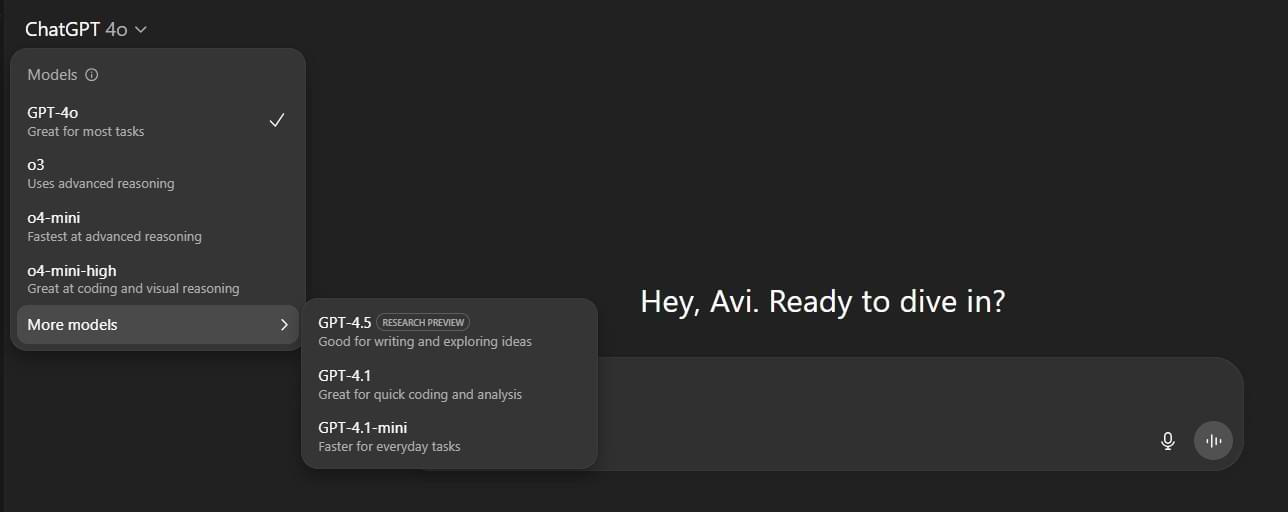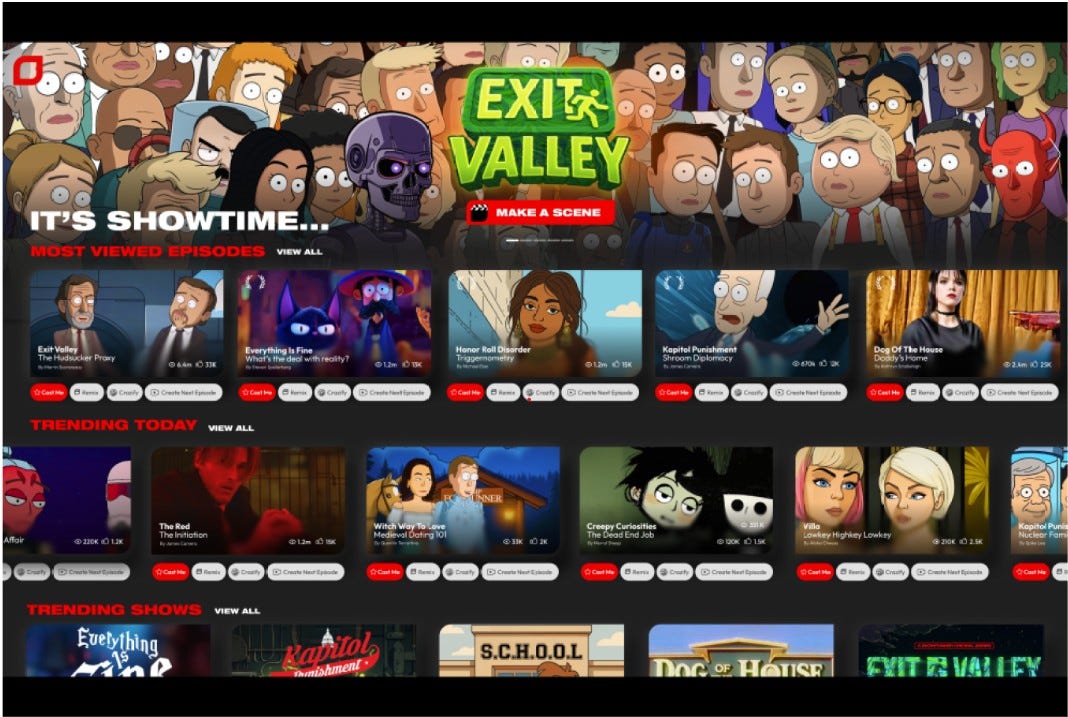Most of us open ChatGPT, type a prompt, and never think about which model we’re using.
Why?
OpenAI’s naming practices are a hot mess and the model picker (click the “GPT-4o” label in the upper-left corner to open it) is both overwhelming and confusing.
But it’s also very powerful and lets you choose the best model for each task.
You can even change the model mid-chat or after each step. This allows you to get dramatically better results.
Before We Dive In: Two Quick Notes
💠 GPT-5 is launching soon (reportedly within the next few weeks). It promises to unify everything so the AI system will automatically route each query to the best suited model.
This sounds great in theory, but power users (including me) will want manual control until it proves it can handle edge cases, which will take time.
💠 If you’re on still on the free tier 🫣, you’re handicapping yourself and operating at a competitive disadvantage. The Plus tier ($20/month) unlocks the most advanced models and capabilities and it’s worth way more than it costs.
When (and Why) to Use Each ChatGPT Model
Here’s a short, practical cheat sheet for my most used models:
GPT-4o – The All-Purpose Default: Fast, capable, and my go-to for 80% of everyday tasks: brainstorming ideas, light research, quick drafts, even working with images or voice.
It’s the “safe bet” model and continues to get smarter every week.
When I’m done thinking things through in o3 (more on that below), I switch to GPT-4o to flesh things out and write.o3 – The Analyst: This is the model I use when I need to think: strategy, complex reasoning, multi-step analysis, and decision making.
It’s sharp and concise—great at stripping away noise and surfacing the key insight.
But that conciseness can also shave off nuance. My workaround:Think with o3 (clarify, outline, structure, key points).
Write with 4o where I can layer depth and tone back in.
It’s capped at 200 messages a week, so I use it intentionally.
o4-mini-high – My Go-To for Search: When I need to dig up info, especially things Google buries, I switch to o4-mini-high. It’s fast and better at surfacing data, particularly for niche research or finding “the weird stuff” on the edges of the internet.
I often bounce between o3 for analysis and o4-mini-high for search in the same chat since o4-mini-high has a higher message cap (150/day).GPT-4.5 – The Writer (hidden in the extended menu): If you click “More models” in the model picker, you’ll find GPT-4.5. It’s the best for nuanced, polished and creative writing. It also feels more “human” than the rest
You only get 10 messages a week, so use them where it counts.
How I Actually Work Across Models
In a single chat, I’ll often:
Think and map strategy in o3.
Jump to o4-mini-high to research, find data, supporting details and sources.
Return to o3 to stress test my thinking, pull everything together and make sure it all makes sense.
Write in GPT-4o (or 4.5) to get language and tone right.
Each model has a lane. Combine them, and ChatGPT stops feeling like one tool, and starts feeling like a toolkit.
What You Need to Know About AI This Week ⚡
Clickable links appear underlined in emails and in orange in the Substack app.
Runway just dropped its biggest update yet. The new model, Aleph, offers far more advanced capabilities to generate, edit and transform videos with simple text prompts.
The company claims that the new model understands what’s already in the footage and builds on it in context, so everything feels more seamless in the editing process.
Here’s what it can do:
Generate new camera angles from existing scenes: Create various perspectives, wide shots, close-ups, or even new tracking shots
Create the next shot in a sequence for a seamless continuation of your story
Apply any style to existing footage to transform videos with your desired aesthetic
Alter a character's appearance: Change age, makeup, wardrobe
Change environments and settings: Shift locations, seasons, or time of day or add effects like rain or sandstorms
Add new elements into an existing scene: Insert crowds, additional characters or props
Remove unwanted objects and elements from footage
Replace or recolor objects or elements in scenes
Apply the motion of a video to images to animate them
Relight shots to create natural or stylized lighting
The demos look incredible. You can see more examples here.
Early access will begin rolling out shortly for all their enterprise and creative partners with broader access coming to all users soon.
—
🤝 Runway has also partnered with IMAX to bring the third edition of the AI Film Festival to select IMAX theatres, featuring four days of screenings across ten cities.
You can learn more and but tickets here.
Amazon is reportedly paying $20–25M a year—about 1% of the New York Times’s annual revenue—to license its content for AI training and Alexa, even as the Times sues OpenAI for unlicensed use.
Two adult film companies are suing Meta for copyright infringement, alleging that the tech giant used their content (nearly 2400 movies) to train its AI models.
🏫 China isn’t debating AI in classrooms. It’s mandating it.
While U.S. schools stay stuck debating plagiarism, China is rethinking “original work” altogether and preparing graduates for a job market where 80% of roles already list AI skills as a plus.
AI skills aren’t just competitive advantages for students. They’re fast becoming baseline for the entire workforce, from CEOs to entry-level hires.
If your company isn’t providing in-depth training on fast-evolving tools like ChatGPT, be proactive. Find a trusted, credible source to upskill, and keep at it.
These tools add major capabilities every month, and they don’t come with manuals. Building fluency happens in layers and takes time and hands-on practice. So, ongoing training is the only way to keep up.
And here’s the reality: the tools your company has licensed (hello Copilot) lag behind and evolve far more slowly, with the gap widening by the month.
Learning the widely used, market-leading tools is what keeps your skills relevant and transferable—across companies, industries, and whatever comes next.
--
Meanwhile, OpenAI released Study Mode in ChatGPT to help students work through problems step-by-step instead of just getting an answer.
To try it, select “Study and learn” from the Tools dropdown menu in ChatGPT.
It’s currently available to free and paid plans, with Edu users will get it in coming weeks.
📺 Amazon is betting on AI that lets anyone create a TV show from scratch.
It just invested in Fable, the company behind Showrunner, a platform hyped as the “Netflix of AI.”
Type in a prompt and the system writes, animates, voices, and edits a scene or a full episode—either from scratch or inside an existing story world.
Fable’s founder calls this “two-way entertainment,” where fans don’t just watch, but co-create or even star in their own episodes.
Amazon’s money is going toward building out the platform, signaling that the retail giant is interested in the underlying technology rather than content.
It likely also an R&D play to explore how audiences might interact with AI-generated series, and prepare for a future where Prime Video experiments with interactive episodes.
But this is the same company that created and pushed out nine AI South Park episodes without permission last year, earning 80M views and a lot of raised eyebrows.
Fable insists that was purely for research purposes and there are now guardrails in place to protect against copyright infringement and offensive or illegal behavior.
The bigger question: will Hollywood trust a company that’s already crossed the line once to put itself on the map?
👀 What happens when a studio rewrites a film’s ending with AI—without asking its director?
Indian studio Eros International did just that with their 2013 hit Raanjhanaa, swapping its tragic ending for a happier one.
Director Aanand L. Rai calls it “a breach of the very idea of authorship” and warns that today’s choices will define creative rights for years to come.
Eros defended the move as a “human-directed reinterpretation” using AI (like VFX or editing) and a “complementary version” that doesn’t replace the original.
The studio plans to “reinterpret” more titles from its 4,000-film library (some with filmmaker involvement, some not).
It’s India’s first high-profile fight over AI-altered films and creative consent, and one Hollywood will be watching closely.
📉 Headlines claims AI is killing grad jobs. The reality’s messier.
Entry-level hiring is way down in the UK and US—especially in finance, tech, and HR—but AI is just one part of the squeeze. Economic uncertainty, global offshoring, and a hiring “correction” post-COVID are playing major roles, too.
Still, Gen Z’s fluency with AI might be their biggest edge, letting them do more with less experience.
Ideogram launched a new dedicated "Character" feature which lets users create and maintain consistent characters across various images—all from a single input image.
You can also place your character in any scene or meme using Magic Fill.
🛒 Walmart has rebuilt its business around AI.
It launched four “super agents”: Sparky is already helping you shop in the app; others will roll out for employees, suppliers, and developers.
It also poached Instacart’s product chief to lead AI—reporting straight to the CEO.
Meanwhile, AI runs through its operations: spotting warehouse defects, planning truck routes, monitoring store equipment, scheduling leave for employees, and translating in real time for staff.
For Walmart, AI has graduated beyond experiments. It’s the engine now.
In case you missed last week’s edition, you can find it 👇:
🤓 ChatGPT Can Now Handle Complex Tasks—By Itself
I’ve been off the grid (mostly) for the past couple weeks—first in London, sweating through record heat in search of shade and wine.
That's all for this week.
I’ll see you next Friday. Thoughts, feedback and questions are always welcome and much appreciated. Shoot me a note at avi@joinsavvyavi.com.
Stay curious,
Avi
💙💙💙 P.S. A huge thank you to my paid subscribers and those of you who share this newsletter with curious friends and coworkers. It takes me about 20+ hours each week to research, curate, simplify the complex, and write this newsletter. So, your support means the world to me, as it helps me make this process sustainable (almost 😄).








This article was enough to push me to subscribe. I have been vacillating on upgrading my ChatGPT from the free plan and your explanation solidified the need to switch. Looking forward to learning more